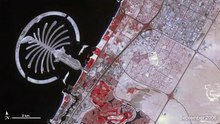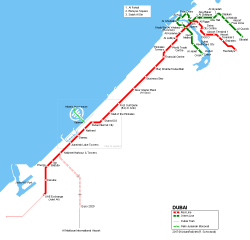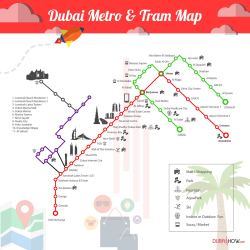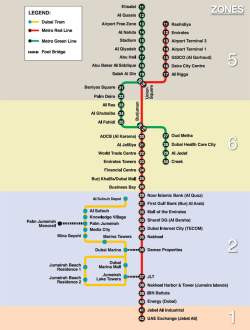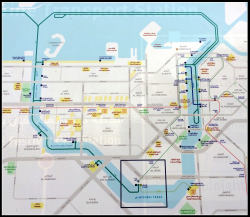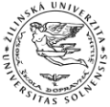Venue
Dubai دبي | |
|---|---|
| Dubai | |
 Clockwise from top left: Skyline with Burj Khalifa; Burj Al Arab; Palm Jumeirah and The World Islands; Dubai Marina; and Sheik Zayed Road. | |
| Coordinates: 25°15′47″N 55°17′50″E / 25.26306°N 55.29722°ECoordinates: 25°15′47″N 55°17′50″E / 25.26306°N 55.29722°E | |
| Country | |
| Emirate | |
| Founded by | Ubaid bin Saeed and Maktum bin Butti Al Maktoum |
| Subdivisions | |
| Government | |
| • Type | Constitutional monarchy |
| • Emir | Mohammed bin Rashid Al Maktoum |
| • Crown Prince | Hamdan bin Mohammed bin Rashid Al Maktoum |
| Area | |
| • Metropolis | 4,114 km2 (1,588 sq mi) |
| Population (8 October 2018)[3] | |
| • Metropolis | 3,137,463 |
| • Metro | ~5,640,000 |
| Demonym(s) | Dubaite |
| Time zone | UTC+4 (UAE Standard Time) |
| Nominal GDP | 2016 estimate |
| Total | USD 108 billion[4] |
| Per capita | USD 35,000 |
| Website | Dubai.ae |
Dubai (/duːˈbaɪ/ doo-BY; Arabic: دبي Dubay, Gulf Arabic: Arabic pronunciation: [dʊˈbɑj]) is the largest and most populous city in the United Arab Emirates (UAE).[5] On the southeast coast of the Persian Gulf, it is the capital of the Emirate of Dubai, one of the seven emirates that make up the country.[6][7][8]
Dubai is a global city and business hub of the Middle East.[9] It is also a major global transport hub for passengers and cargo.[10] Oil revenue helped accelerate the development of the city, which was already a major mercantile hub, but Dubai's oil reserves are limited and production levels are low: today, less than 5% of the emirate's revenue comes from oil.[11] A growing centre for regional and international trade since the early 20th century, Dubai's economy today relies on revenues from trade, tourism, aviation, real estate, and financial services.[12][13][14][15]
Dubai has attracted world attention through large construction projects and sports events, in particular the world's tallest building, the Burj Khalifa. As of 2012[update], Dubai was the most expensive city in the Middle East.[16][17] In 2014, Dubai's hotel rooms were rated as the second most expensive in the world.[18][19]
Geography
Dubai is situated on the Persian Gulf coast of the United Arab Emirates and is roughly at sea level (16 m or 52 ft above). The emirate of Dubai shares borders with Abu Dhabi in the south, Sharjah in the northeast, and the Sultanate of Oman in the southeast. Hatta, a minor exclave of the emirate, is surrounded on three sides by Oman and by the emirates of Ajman (in the west) and Ras Al Khaimah (in the north). The Persian Gulf borders the western coast of the emirate. Dubai is positioned at 25°16′11″N 55°18′34″E / 25.2697°N 55.3095°E and covers an area of 1,588 sq mi (4,110 km2), which represents a significant expansion beyond its initial 1,500 sq mi (3,900 km2) designation due to land reclamation from the sea.[citation needed]
Dubai lies directly within the Arabian Desert. However, the topography of Dubai is significantly different from that of the southern portion of the UAE in that much of Dubai's landscape is highlighted by sandy desert patterns, while gravel deserts dominate much of the southern region of the country.[1] The sand consists mostly of crushed shell and coral and is fine, clean and white. East of the city, the salt-crusted coastal plains, known as sabkha, give way to a north-south running line of dunes. Farther east, the dunes grow larger and are tinged red with iron oxide.[2]
The flat sandy desert gives way to the Western Hajar Mountains, which run alongside Dubai's border with Oman at Hatta. The Western Hajar chain has an arid, jagged and shattered landscape, whose mountains rise to about 1,300 metres (4,265 feet) in some places. Dubai has no natural river bodies or oases; however, Dubai does have a natural inlet, Dubai Creek, which has been dredged to make it deep enough for large vessels to pass through. Dubai also has multiple gorges and waterholes, which dot the base of the Western Al Hajar mountains. A vast sea of sand dunes covers much of southern Dubai and eventually leads into the desert known as The Empty Quarter. Seismically, Dubai is in a very stable zone—the nearest seismic fault line, the Zagros Fault, is 200 kilometres (124 miles) from the UAE and is unlikely to have any seismic impact on Dubai.[3] Experts also predict that the possibility of a tsunami in the region is minimal because the Persian Gulf waters are not deep enough to trigger a tsunami.[3]

The sandy desert surrounding the city supports wild grasses and occasional date palms. Desert hyacinths grow in the sabkha plains east of the city, while acacia and ghaf trees grow in the flat plains within the proximity of the Western Al Hajar mountains. Several indigenous trees such as the date palm and neem as well as imported trees such as the eucalypts grow in Dubai's natural parks. The houbara bustard, striped hyena, caracal, desert fox, falcon and Arabian oryx are common in Dubai's desert. Dubai is on the migration path between Europe, Asia and Africa, and more than 320 migratory bird species pass through the emirate in spring and autumn. The waters of Dubai are home to more than 300 species of fish, including the hammour. The typical marine life off the Dubai coast includes tropical fish, jellyfish, coral, dugong, dolphins, whales and sharks. Various types of turtles can also be found in the area including the hawksbill turtle and green turtle, which are listed as endangered species.[4][5]
Dubai Creek runs northeast-southwest through the city. The eastern section of the city forms the locality of Deira and is flanked by the emirate of Sharjah in the east and the town of Al Aweer in the south. The Dubai International Airport is located south of Deira, while the Palm Deira is located north of Deira in the Persian Gulf. Much of Dubai's real-estate boom is concentrated to the west of Dubai Creek, on the Jumeirah coastal belt. Port Rashid, Jebel Ali, Burj Al Arab, the Palm Jumeirah and theme-based free-zone clusters such as Business Bay are all located in this section.[6] Dubai is notable for sculpted artificial island complexes including the Palm Islands and The World archipelago.
Economy
One of the world's fastest growing economies,[1] Dubai's gross domestic product is projected at US$107.1 billion, with a growth rate of 6.1% in 2014.[2] Although a number of core elements of Dubai's trading infrastructure were built on the back of the oil industry,[3] revenues from oil and natural gas account for less than 5% of the emirate's revenues.[4] It is estimated that Dubai produces 50,000 to 70,000 barrels (7,900 to 11,100 m3) of oil a day[5] and substantial quantities of gas from offshore fields. The emirate's share in the UAE's total gas revenues is about 2%. Dubai's oil reserves have diminished significantly and are expected to be exhausted in 20 years.[6] Real estate and construction (22.6%),[7] trade (16%), entrepôt (15%) and financial services (11%) are the largest contributors to Dubai's economy.[8]
Dubai's non-oil foreign trade stood at $362 billion in 2014. Of the overall trade volumes, imports had the biggest share with a value of $230 billion while exports and re-exports to the emirate stood at $31 billion and $101 billion respectively.[9]
By 2014, China had emerged as Dubai's largest international trading partner, with a total of $47.7 billion in trade flows, up 29% from 2013. India was second among Dubai's key trading partners with a trade of $29.7 billion, followed by the United States at $22.62 billion. The Kingdom of Saudi Arabia was Dubai's fourth trading partner globally and first in the GCC and Arab world with a total trade value of $14.2 billion. Trade with Germany in 2014 totalled $12.3, Switzerland and Japan both at $11.72 billion and UK trade totalled $10.9 billion.[9]
Historically, Dubai and its twin across Dubai Creek, Deira (independent of Dubai City at that time), were important ports of call for Western manufacturers. Most of the new city's banking and financial centres were headquartered in the port area. Dubai maintained its importance as a trade route through the 1970s and 1980s. Dubai has a free trade in gold and, until the 1990s, was the hub of a "brisk smuggling trade"[10] of gold ingots to India, where gold import was restricted. Dubai's Jebel Ali port, constructed in the 1970s, has the largest man-made harbour in the world and was ranked seventh globally for the volume of container traffic it supports.[11] Dubai is also a hub for service industries such as information technology and finance, with industry-specific free zones throughout the city.[12] Dubai Internet City, combined with Dubai Media City as part of TECOM (Dubai Technology, Electronic Commerce and Media Free Zone Authority), is one such enclave, whose members include IT firms such as Hewlett Packard Enterprise, HP Inc., Google, EMC Corporation, Oracle Corporation, Microsoft, Dell and IBM, and media organisations such as MBC, CNN, BBC, Reuters, Sky News and AP.[citation needed]
The government's decision to diversify from a trade-based, oil-reliant economy to one that is service- and tourism-oriented made property more valuable, resulting in the property appreciation from 2004 to 2006. A longer-term assessment of Dubai's property market, however, showed depreciation; some properties lost as much as 64% of their value from 2001 to November 2008.[13] The large-scale real estate development projects have led to the construction of some of the tallest skyscrapers and largest projects in the world such as the Emirates Towers, the Burj Khalifa, the Palm Islands and the most expensive hotel, the Burj Al Arab.[14] Dubai's property market experienced a major downturn in 2008[15] and 2009 as a result of the slowing economic climate.[16] By early 2009, the situation had worsened with the Great Recession taking a heavy toll on property values, construction and employment.[17] This has had a major impact on property investors in the region, some of whom were unable to release funds from investments made in property developments.[18] As of February 2009[update], Dubai's foreign debt was estimated at approximately $80 billion, although this is a tiny fraction of the sovereign debt worldwide.[19] Dubai real estate and UAE property experts believe that by avoiding the mistakes of the past, Dubai's realty market can achieve stability in the future.[20]
The Dubai Financial Market (DFM) was established in March 2000 as a secondary market for trading securities and bonds, both local and foreign. As of fourth quarter 2006, its trading volume stood at about 400 billion shares, worth $95 billion in total. The DFM had a market capitalisation of about $87 billion.[21] The other Dubai-based stock exchange is NASDAQ Dubai, which is the international stock exchange in the Middle East. It enables a range of companies, including UAE and regional small and medium-sized enterprises, to trade on an exchange with an international brand name, with access by both regional and international investors.[22]
DMCC (Dubai Multi Commodities Centre) was established in 2002. It's world's fastest growing free zone and been nominated as "Global Free Zone of the Year 2016" by The Financial Times fDi Magazine.
Dubai is also known as the City of Gold, because a major part of the economy is based on gold trades, with Dubai's total gold trading volumes in H1 2011 reaching 580 tonnes, with an average price of US$1,455 per troy ounce.[23]
A City Mayors survey ranked Dubai 44th among the world's best financial cities in 2007,[24] while another report by City Mayors indicated that Dubai was the world's 27th richest city in 2012, in terms of purchasing power parity (PPP).[25] Dubai is also an international financial centre (IFC) and has been ranked 37th within the top 50 global financial cities as surveyed by the MasterCard Worldwide Centres of Commerce Index (2007),[26] and 1st within the Middle East. Since it opened in September 2004, the Dubai IFC has attracted, as a regional hub, leading international firms and set-up the NASDAQ Dubai which lists equity, derivatives, structured products, Islamic bonds (sukuk) and other bonds. The Dubai IFC model is an independent risk-based regulator with a legislative system consistent with English common law.[27]
In 2012, the Global City Competitiveness Index by the Economist Intelligence Unit ranked Dubai at No. 40 with a total score of 55.9. According to its 2013 research report on the future competitiveness of cities, in 2025, Dubai will have moved up to 23rd place overall in the Index.[28] Indians, followed by Britons and Pakistanis are the top foreign investors in Dubai realty.[29]
Dubai has launched several major projects to support its economy and develop different sectors. These include Dubai Fashion 2020,[30] and Dubai Design District, expected to become a home to leading local and international designers. The AED 4 billion first phase of the project will be complete by January 2015.[31]
Tourism and retail


Tourism is an important part of the Dubai government's strategy to maintain the flow of foreign cash into the emirate. Dubai's lure for tourists is based mainly on shopping,[32][33] but also on its possession of other ancient and modern attractions.[34] As of 2018, Dubai is the fourth most-visited city in the world based on the number of international visitors and the fastest growing, increasing by a 10.7% rate.[35] The city hosted 14.9 million overnight visitors in 2016, and is expected to reach 20 million tourists by 2020.[36]

Dubai has been called the "shopping capital of the Middle East".[37] Dubai alone has more than 70 shopping centres, including the world's largest shopping centre, Dubai Mall. Dubai is also known for the historical souk districts located on either side of its creek. Traditionally, dhows from East Asia, China, Sri Lanka, and India would discharge their cargo and the goods would be bargained over in the souks adjacent to the docks. Dubai Creek played a vital role in sustaining the life of the community in the city and was the resource which originally drove the economic boom in Dubai.[38] As of September 2013[update], Dubai creek has been proposed as a UNESCO World Heritage Site.[39] Many boutiques and jewellery stores are also found in the city. Dubai is also referred to as "the City of Gold" as the Gold Souk in Deira houses nearly 250 gold retail shops.[40]

Dubai Creek Park in Dubai Creek also plays a vital role in Dubai tourism as it showcase some of the most famous tourist attractions in Dubai such as Dolphinarium, Cable Car, Camel Ride, Horse Carriage and Exotic Birds Shows.[41]
Dubai has a wide range of parks like Safa park, Mushrif park, Hamriya park etc. Each park is uniquely distinct from the other. Mushrif park showcases different houses around the world. A visitor can check out the architectural features of the outside as well as the inside of each house.
Some of the most popular beaches in Dubai are Umm Suqeim Beach, Al Mamzar Beach Park, JBR Open Beach, Kite Beach, Black Palace Beach and Royal Island Beach Club.
Expo 2020
On 2 November 2011, four cities had their bids for Expo 2020 already lodged, with Dubai making a last-minute entry. The delegation from the Bureau International des Expositions, which visited Dubai in February 2013 to examine the Emirate's readiness for the largest exposition, was impressed by the infrastructure and the level of national support. In May 2013, Dubai Expo 2020 Master Plan was revealed.[42] Dubai then won the right to host Expo 2020 on 27 November 2013.[43] The event will bring huge economic benefits by generating activities worth billions of dirhams and may create over 270,000 jobs.[44]
The main site of Dubai Expo 2020 will be a 438-hectare area (1,083 acres), part of the new Dubai Trade Centre Jebel Ali urban development, located midway between Dubai and Abu Dhabi.[45] Moreover, the Expo 2020 also created various social enlistment projects and monetary boons to the city targeting the year 2020. Such as initiating the world's largest solar project,[46] the real estate upsurge, to focus on the GDP growth and to make Dubai a "Happy Dubai" for the people of the city.[47]
Climate
Dubai has a hot desert climate. Summers in Dubai are extremely hot, windy, and humid, with an average high around 41 °C (106 °F) and overnight lows around 30 °C (86 °F) in the hottest month, August. Most days are sunny throughout the year. Winters are comparatively cool with an average high of 24 °C (75 °F) and overnight lows of 14 °C (57 °F) in January, the coldest month. Precipitation, however, has been increasing in the last few decades, with accumulated rain reaching 110.7 mm (4.36 in) per year.[1] Dubai summers are also known for the very high humidity level, which can make it very uncomfortable for many with exceptionally high dew points in summer.[2] The highest recorded temperature in Dubai is 48.4 °C (119 °F), reached in July 1996.[3]
| Climate data for Dubai | |||||||||||||
|---|---|---|---|---|---|---|---|---|---|---|---|---|---|
| Month | Jan | Feb | Mar | Apr | May | Jun | Jul | Aug | Sep | Oct | Nov | Dec | Year |
| Record high °C (°F) | 31.6 (88.9) |
37.5 (99.5) |
41.3 (106.3) |
43.5 (110.3) |
47.0 (116.6) |
46.7 (116.1) |
49.0 (120.2) |
48.7 (119.7) |
45.1 (113.2) |
42.0 (107.6) |
41.0 (105.8) |
35.5 (95.9) |
49.0 (120.2) |
| Average high °C (°F) | 23.9 (75.0) |
25.4 (77.7) |
28.3 (82.9) |
33.0 (91.4) |
37.7 (99.9) |
39.5 (103.1) |
40.9 (105.6) |
41.3 (106.3) |
38.9 (102.0) |
35.4 (95.7) |
30.6 (87.1) |
26.2 (79.2) |
33.4 (92.2) |
| Daily mean °C (°F) | 19.1 (66.4) |
20.5 (68.9) |
23.0 (73.4) |
27.0 (80.6) |
31.4 (88.5) |
33.4 (92.1) |
35.5 (95.9) |
35.9 (96.6) |
33.3 (91.9) |
29.8 (85.6) |
25.4 (77.7) |
21.2 (70.2) |
28.0 (82.3) |
| Average low °C (°F) | 14.3 (57.7) |
15.5 (59.9) |
17.7 (63.9) |
21.0 (69.8) |
25.1 (77.2) |
27.3 (81.1) |
30.0 (86.0) |
30.4 (86.7) |
27.7 (81.9) |
24.1 (75.4) |
20.1 (68.2) |
16.3 (61.3) |
22.5 (72.4) |
| Record low °C (°F) | 1.5 (34.7) |
6.9 (44.4) |
9.0 (48.2) |
13.4 (56.1) |
15.1 (59.2) |
18.2 (64.8) |
20.4 (68.7) |
23.1 (73.6) |
16.5 (61.7) |
15.0 (59.0) |
11.8 (53.2) |
8.2 (46.8) |
1.5 (34.7) |
| Average precipitation mm (inches) | 18.8 (0.74) |
25.0 (0.98) |
22.1 (0.87) |
7.2 (0.28) |
0.4 (0.02) |
0.0 (0.0) |
0.8 (0.03) |
0.0 (0.0) |
0.0 (0.0) |
1.1 (0.04) |
2.7 (0.11) |
16.2 (0.64) |
94.3 (3.71) |
| Average precipitation days | 5.5 | 4.7 | 5.8 | 2.6 | 0.3 | 0.0 | 0.5 | 0.5 | 0.1 | 0.2 | 1.3 | 3.8 | 25.3 |
| Mean monthly sunshine hours | 251 | 241 | 270 | 306 | 350 | 345 | 332 | 326 | 309 | 307 | 279 | 254 | 3,570 |
| Mean daily sunshine hours | 8.1 | 8.6 | 8.7 | 10.2 | 11.3 | 11.5 | 10.7 | 10.5 | 10.3 | 9.9 | 9.3 | 8.2 | 9.8 |
| Source #1: Dubai Meteorological Office[4] | |||||||||||||
| Source #2: UAE National Center of Meteorology[5] | |||||||||||||
Parts of this text and pictures were copied from 
Conference Venue
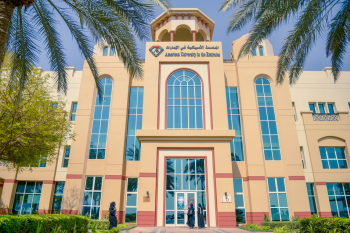
|
|
Getting to Dubai and the American University in the Emirates 
Entry document requirements into Dubai - UAE
When flying to Dubai or the UAE make sure your travel documents are in order, so you can enter Dubai or the UAE for the conference. Hereafter you will find some links to make sure.
- Do you need an entry permit or a visa to enter the UAE?
- UAE visa information
- Dubai Tourist Visa & Entry Information
By Plane






|
When arriving by plane in Dubai you will arrive at Dubai International Airport (IATA: DXB), the hub for the Emirates, which serves the city of Dubai and other emirates in the country. The airport is the third-busiest airport in the world by passenger traffic and the world's busiest airport by international passenger traffic. Emirates is the national airline of Dubai. As of 2018, it operated internationally serving over 150 destinations in over 70 countries across six continents. A list of other airlines flying to Dubai can be found here.
From Dubai International Airport you can take either a bus or taxi
to the American University in the Emirates or to the desginated conference hotel.
By Bus
By Taxi There are car hire services available at Palma Airport. In total, there are five companies offering this service. Autos Ancar offers a variety of vehicles to fit a large range of clientele. Similarly, these services can be obtained from Avis, Cicar, Europcar or Hertz. The services are available on arrival at the airport. The hiring price of vehicles ranges from about €140 to €300 per week, depending on your vehicle of choice. The price also varies according to the season. |
By Metro Rail and Monorail

|
Metrorail Palm Jumeirah Monorail |
By Tram |
Dubai Tram |
By Watertaxi |
Dubai Water Taxi |
By Taxi |
The American University in the Emirates is easily reachable by taxi |
By Car |
A car park is available to visitors to The American University in the Emirates |
American University in the Emirates Location Map
Dubai Rail/Metro/Tram Maps
Click on the Maps below for a more detailed view




